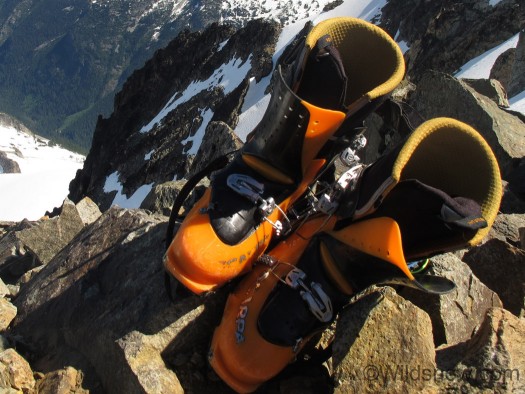Shop for Scarpa Maestrale and Maestrale RS
I used the Scarpa Maestrale boot all last winter, spring and now summer — a legendary ski season up here in the great Pacific Northwest. These are incredible backcountry skiing shoes, lightweight, with an unreal walk mode and sufficient stiffness to make skiing downhill fun. Since they’re a bit on the softer side, I use the Maestrale for my longer tours and for trips where I want lighter gear. That’s most of my travels.
After using my Maestrales on miles of snow, rock, dirt, and ice, they are beginning to show some character. We’ve done a few Scarpa Maestrale reviews here on WildSnow, but this is our first “long term” report. Thus, I’ll skip the technical details and focus on what I loved about the boots, and what I didn’t.
With the assistance of thermomoldable liners, I tend to fit most boots well. Scarpas are no exception. I configured my Maestrale fit to be a fairly tight “performance” type, in order to eek as much downhill action out of them as I could, and since my feet stay pretty warm.
Even with such a semi performance fit, due in large part to the great flexibility in walk mode my Maestrale are very comfortable — even comfy all day (around here, we seem to define “day” as any trip over 10 hours.) I did lose a few toenails this year, something that hasn’t ever happened before. Perhaps this happened because of the tighter fit, or maybe the ridiculously long season I’ve had is as hard on my feet as it is on boots.
In my opinion, the most important aspect of an AT boot is the ratio of loose walk mode and stiff ski mode. The Maestrales are some of the best out there in this regard. I usually hike with all the buckles loose, and the walk mode is dreamy. When buckled down for the descent, the boot locks up well. As a test of just how far one can take these boots, I used the Maestrales a bit during midwinter on my Black Diamond Megawatts. There was enough to power the ski in soft powder, but it got overpowered on harder snow. On my smaller K2 Coombacks and Waybacks, they work well in all conditions.
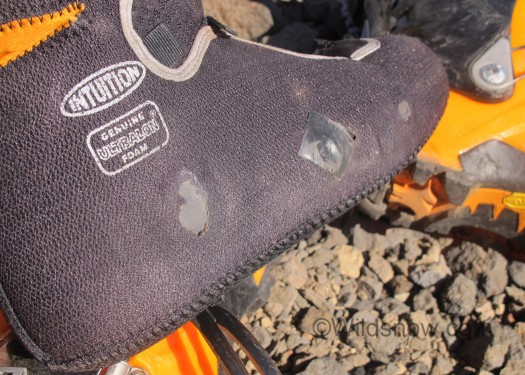
Intuition Liners are awesome, and the ones Intuition makes for Scarpa are no exception. The side of the liner is showing some wear from the interior of the boot. I applied some duct tape to prevent this, but most fell off pretty quickly.
Another terrific feature of the Maestrale is the power strap. It is similar to a Booster Strap, in that it is made out of burly elastic. However it has a traditional velcro closure instead of the cam buckle like a booster strap. I use a booster strap on some of my other boots. They are heavy, and freeze up after a long day. You can’t tighten the velcro straps as much, however they are much better for an AT boot.
The Maestrales are a 4 buckle boot, however I found the 4th buckle to be unnecessary. If I buckled it comfortably, the 4th buckle would come loose and flop around, If I buckled it tight enough to stay in place, it was very uncomfortable, and I didn’t notice any improvement in how the boot skied. I took the lower buckle off, and filled the holes with silicone caulk. This reduced a little weight, and also made the front of the boot have a slimmer profile nice for rock scrambling.
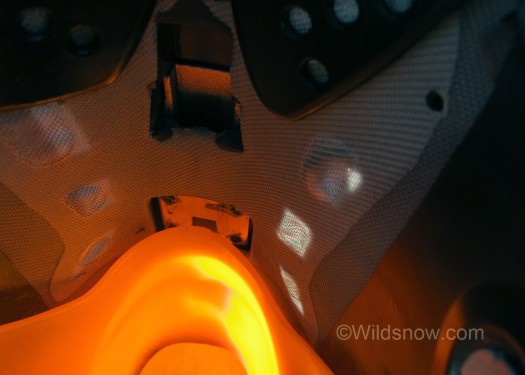
The waterproof fabric covering the holes in the cuff is holding up well. I expected this stuff to wear through, I'm happy it didn't.
Speaking of scrambling, I’ve done quite a bit this season, as well as a fair amount of dirt walking and even standing on some boot chomping snowmo running boards. The boot has held up pretty well to all the abuse I’ve thrown at it. While worn, the sole rubber is still intact. The plastic in the toe and heel area is also holding up well. I sometimes have problems with wearing a hole in the heel area of my liner, but the liners that came with the boot have resisted that well. I don’t tend to be extremely hard on my gear, but I do use it a lot, and for the most part I’m happy with the durability of the Maestrales.
That being said, this past season’s Maestrales do have one issue when it comes to durability, an issue I have definitely experienced. Most buckles and parts are attached with screws, which is great for customizing and repairing them, however I’ve had numerous problems with the screws coming undone. Several came loose on a single trip up Mount Baker; luckily just the lower buckles, so I was able to make it down easy enough.
I originally put blue Loctite on the screws, then red, and finally used epoxy as thread locker after they kept coming loose. The epoxy seems to hold them fairly well. But during my most recent ski trip to Mt. Adams up here in the PNW the screw holding the lowest buckle on the boot fell out. This is the first screw to come loose after securing them with epoxy.
When this problem with the screws surfaced last winter, it was conjectured that the Loctite used at the factory was defective, or perhaps the threads were contaminated with grease or something else that compromised the thread locker. Now that I’ve used epoxy and still had a screw come loose, I’m thinking something else is going on. Perhaps the screws are simply so short that very little thread really engages and they simply exceed their physical ability to stay tight.
Whatever the case, word from Scarpa is they’ll be going back to using regular press rivets instead of the problematic screws. We’re of course disappointed it had to come to that, since having things on boots attached in a way they can be easily replaced or removed is a dream for mods and repairs. But whatever works must be done.
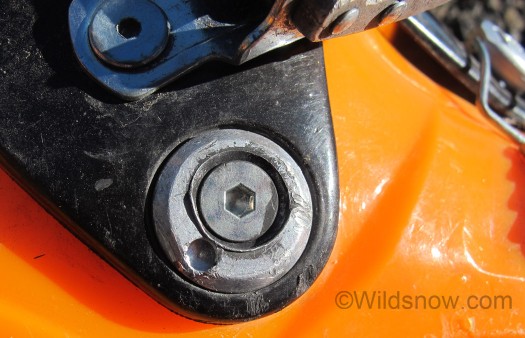
The screw on this cant rivet came loose and I didn't notice it for a few trips. It wore the rivet a bit, but still works. Other brands of boots can have this problem as well. Solution is plenty of Loctite and mindful maintenance. The more serious problem of this nature occurred with the smaller screws attaching the buckles and tongue hinges.
In terms of durability, I should also mention that I broke a few of the tiny hinges that let the tongue swing to the side. These are easy to fix, and will be beefed in this year’s version of the boot. Even with them broken you can still ski, so I don’t view this as something to panic about.
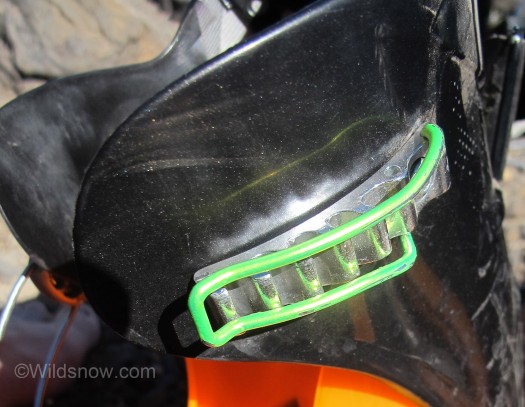
The top buckle of the boot has this green clip to keep the buckle in place. It's a nice feature, but one of them fell off within a few weeks of use.
The only other issue I have had with the Maestrale is with the ski/walk latch mechanism. After long periods in walk mode in cold weather they freeze up. They do this more readily than the walk mode latches on my other ski boots. A few whacks with a ski pole is enough to fix the problem, but it’s still annoying. The mechanism is exposed on the outside of the boot, unlike others that are placed inside, next to the liner. I believe this makes it collect more ice and snow, as well as any ice not being melted or softened by the heat from the liner. I’ve spoken about this with other Maestrale users and we’ve reached no consensus on how to prevent the problem. Liberal doses of spray silicone would probably help, as would keeping the cuff of your pants down low so it protects the machinery from water intrusion.
I was excited when I first got the Maestrales, since they seemed like such an innovative boot. They proved to be just that, and enabled a ski season that is nothing less than legend.
Louie Dawson earned his Bachelor Degree in Industrial Design from Western Washington University in 2014. When he’s not skiing Mount Baker or somewhere equally as snowy, he’s thinking about new products to make ski mountaineering more fun and safe.

